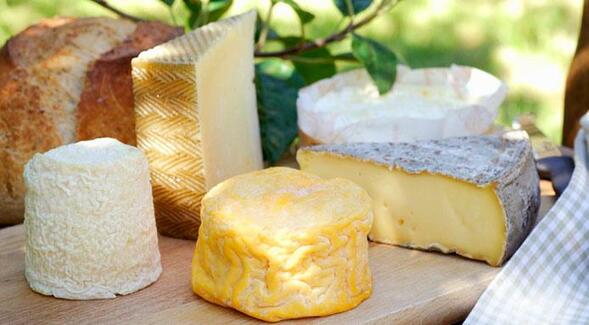Formaggio e Frutta (Cheese and Fruit)

The history of cheese in Italy is very closely related to the country’s varied geography. The rich mountainous pastures of the North produce hundreds of cheeses like fontina, Gorgonzola, mascarpone, Asiago, Grana Padano and Teleggio. In the Centre, Emilia-Roagna is the home of Parmigiano Reggiano (parmesan), perhaps Italy’s most famous cheese. Tuscany and Umbria produce fresh pecorinos, while the sparser and hotter South is more suited to farming goats and sheep than cows.
This course should be prepared with ‘cleansing the diners’ palettes’ in preparation for the sweet dessert to follow.
Because Italy has 309 different DOP cheeses (Denomination of Origin Protected), there are so many possibilities when it comes to creating an Italian cheese plate. First, you want your cheese plate to be a representation of the 4 most important milks that are behind all excellent cheeses:
Cow's Milk: There are many aged in different conditions (it is the maturation of the cows milk that makes the varieties most interesting, whether it's matured under ash, grape leaves, etc.) Of course, the king of all cow's milk is Parmigiano-Reggiano, which undergoes a special maturation of up to 36
months.
Water Buffalo Milk: The most common type of water buffalo milk cheese is Mozzarella di Bufala, which has a firmer texture than cow's milk mozzarella and is tangy in flavor. Mozzarella di Bufala Classica, which is more savoury and mild, might be more suitable for your guests’ palates.
Sheep's Milk: The ultimate sheep's milk is pecorino, usually aged 1 month to 2 Months. There are many different varieties with different grades of toughness including Romano, Fiore Sardo and Pecorino di Pienza etc.
Goat's Milk: There are many different types of goat cheese, from fresh to aged (which are more pungent). You can finish your plate with a Tre Latti, or three milk cheese from Piemonte, a bite of Taleggio from Lombardia and soft or hard Gorgonzola, the blue cheese of Italy.
Don’t overdo.
Don’t overdo the accompaniments: a classic Italian cheese and fruit course, should comprise some very good bread (or in some cases, polenta), crisp apples or pears (pears and Parmigainno-Reggiano is a great pairing), dried fruits like apricots, nuts such as salted almonds and pistachios and for a special touch with the Parmigiana-Reggiano – honey!
This course should be prepared with ‘cleansing the diners’ palettes’ in preparation for the sweet dessert to follow.
Because Italy has 309 different DOP cheeses (Denomination of Origin Protected), there are so many possibilities when it comes to creating an Italian cheese plate. First, you want your cheese plate to be a representation of the 4 most important milks that are behind all excellent cheeses:
Cow's Milk: There are many aged in different conditions (it is the maturation of the cows milk that makes the varieties most interesting, whether it's matured under ash, grape leaves, etc.) Of course, the king of all cow's milk is Parmigiano-Reggiano, which undergoes a special maturation of up to 36
months.
Water Buffalo Milk: The most common type of water buffalo milk cheese is Mozzarella di Bufala, which has a firmer texture than cow's milk mozzarella and is tangy in flavor. Mozzarella di Bufala Classica, which is more savoury and mild, might be more suitable for your guests’ palates.
Sheep's Milk: The ultimate sheep's milk is pecorino, usually aged 1 month to 2 Months. There are many different varieties with different grades of toughness including Romano, Fiore Sardo and Pecorino di Pienza etc.
Goat's Milk: There are many different types of goat cheese, from fresh to aged (which are more pungent). You can finish your plate with a Tre Latti, or three milk cheese from Piemonte, a bite of Taleggio from Lombardia and soft or hard Gorgonzola, the blue cheese of Italy.
Don’t overdo.
Don’t overdo the accompaniments: a classic Italian cheese and fruit course, should comprise some very good bread (or in some cases, polenta), crisp apples or pears (pears and Parmigainno-Reggiano is a great pairing), dried fruits like apricots, nuts such as salted almonds and pistachios and for a special touch with the Parmigiana-Reggiano – honey!
